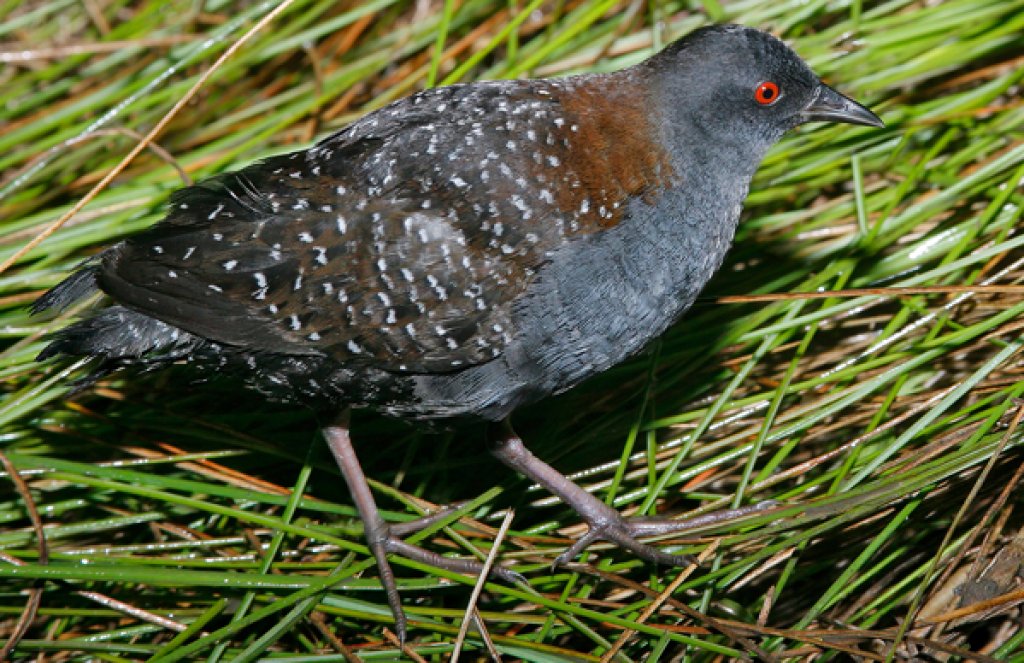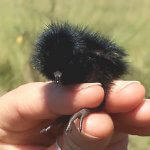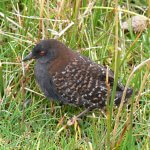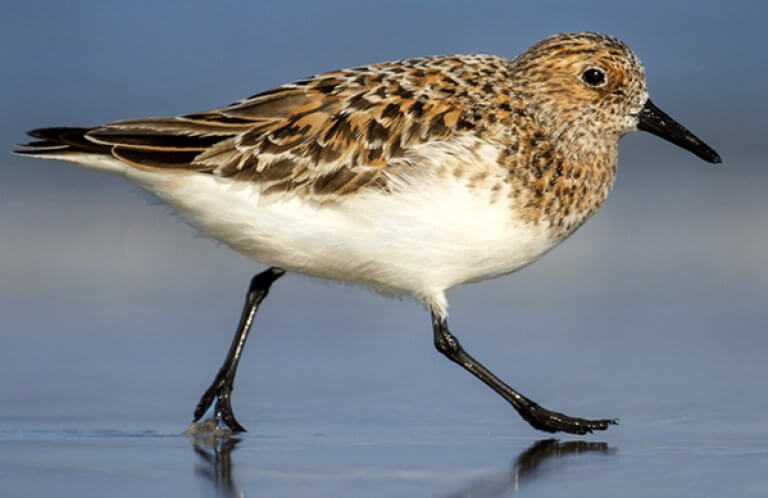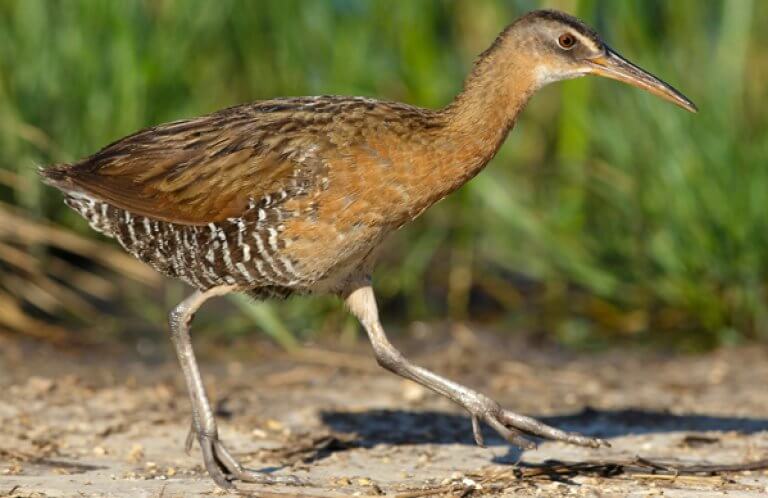About the Black Rail
The Black Rail is the smallest of its family in North America. It measures just three-quarters of an inch longer than the Saltmarsh Sparrow, with which it shares Atlantic Coast marshland, and weighs about as much as a Semipalmated Sandpiper. This enigmatic bird skulks and scurries behind dense screens of vegetation. It is most often detected during breeding season, when males' distinctive calls pierce the night.
Mousy Ways
Ornithologists suspect that this rarely seen species takes advantage of the work of its rodent neighbors, using worn mouse pathways to navigate through dense cover. These hidden byways are especially useful because, like the King Rail, the Black Rail's preferred method of “flight” is to run, not fly, from trouble.
Songs and Sounds
A Call of the Wilds
The male Black Rail calls loudly and frequently during the mating season with a distinctive three- or four-note vocalization: "kick-ee-doo" or “kick-kick-ee-doo.”
Listen to the four-note call here:
This bird also emits a growling call:
Breeding and Feeding
Top-Secret Nester
Much remains to be learned about how Black Rails breed, including how they select nest sites, construct nests, whether or not they maintain or reuse nests, and how these birds raise their young. Ornithologists have documented few nests, but enough over the years to provide a general description: Black Rail nests are made of plants dominant to the area, and consist of a bowl where usually six to eight eggs are laid, with a concealing overhang of living or dead vegetation and a ramp running up one side from the ground. Nests are usually placed just a few inches above shallow water or moist soil, amid plant clumps and usually at a high point in a marsh.
Both parents are thought to incubate the eggs for almost three weeks. Once they hatch, the black, downy chicks stay in the nest less than a day before ambling out into their wetland world, but they likely return at night for a few days, where they are probably brooded by a parent.
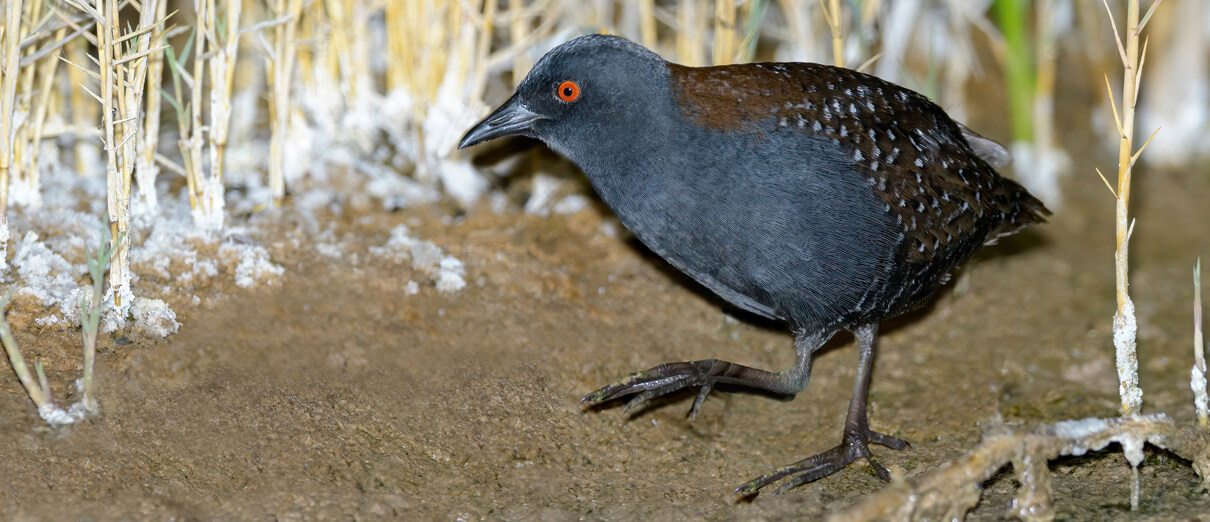
Although they frequently call at night, Black Rails likely forage primarily during the day. Few have seen this bird feeding, but ornithologists think the Black Rail hunts by sight like many other rails, plucking prey from the soil and vegetation. Examinations of stomach contents revealed that the Black Rail's diet includes many invertebrates, such as aquatic beetles, spiders, snails, and small crustaceans, as well as a variety of seeds.
Region and Range
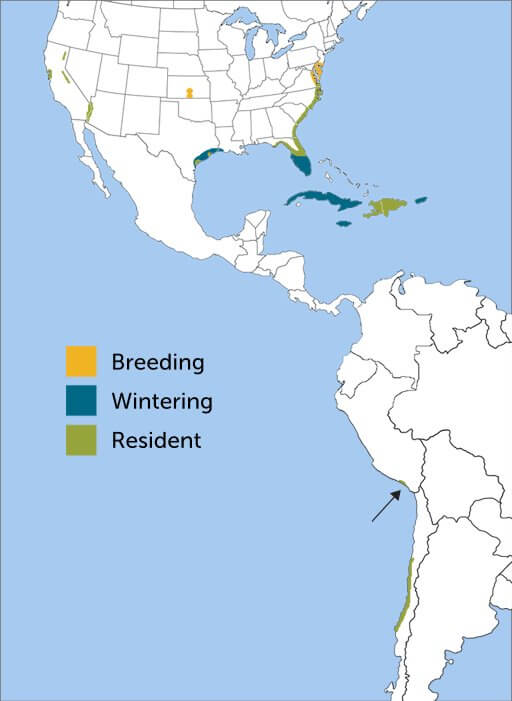
There are several described Black Rail subspecies, two of which occur in the United States. In many areas, calling birds may occur for a year or a few years, then vanish. The “Eastern” Black Rail occurs from New Jersey south along the Atlantic and Gulf Coasts and at a few inland areas, including in central Kansas. This subspecies' northern populations winter to the south, including in South Florida, along the Gulf Coast, and in parts of the Caribbean.
The “California” subspecies is resident, occurring in coastal sections of central California including the San Francisco Bay area, as well as a few other sites, such as a stretch of the lower Colorado River along the California/Arizona state lines, south to the border with Mexico.
Black Rails also breed on the Caribbean island of Hispaniola and in isolated resident populations in a few parts of South America: one in central Chile along the coast and in Peru. The species may breed elsewhere: Over the years, breeding-season reports have come from Veracruz (Mexico), Belize, Panama, Costa Rica, Honduras, Cuba, Jamaica, Puerto Rico, and western Argentina.
Conservation of the Black Rail
“Invisible” Versus Oblivion
If it can't be seen, the Black Rail can at least be heard on breeding grounds. But many of the species' former haunts have fallen silent. The Black Rail population declined sharply in recent decades, likely due to increasing development in coastal areas, which has caused habitat loss and degradation of suitable breeding areas. This bird is also vulnerable to nest predators such as raccoons, cats, and rats, while invasive plants such as Phragmites reeds crowd out native marsh vegetation and result in a further loss of habitat. But the biggest threat to the Black Rail may be climate change: In areas of tidal marsh, Black Rails tend to occur at the highest parts. It is thought that along the Atlantic Coast rising sea levels have spurred rapid population declines, as areas flood with more frequency, and as wetlands subside, giving way to open water.
This species is categorized as Endangered on the IUCN Red List, and is listed as a “Tipping Point” species in the 2022 State of the Birds report, meaning it has lost 50 percent or more of its population in the past 50 years and is on track to lose another 50 percent in the next five decades if nothing changes.

Help support ABC's conservation mission!
The “Eastern” Black Rail is listed as Threatened under the U.S. Endangered Species Act. Since the 1990s, known Atlantic Coast populations declined by more than 90 percent, and the northern limit of the population's breeding range contracted southward from Massachusetts to New Jersey, according to the Atlantic Coast Joint Venture (ACJV), of which ABC is a partner. The ACJV aims to restore the Atlantic Coast population of the Eastern Black Rail in core areas where breeding populations are found, with the goal of conserving areas where populations can expand to as well. This JV also works to conserve other flagship species such as the American Black Duck and Saltmarsh Sparrow.
The scarce “California” Black Rail population also likely warrants federal listing due to sharp declines in habitat, as well as likely impacts from long-term drought.
The enactment of wetland protection measures in the U.S. in recent decades may have helped stabilize some Black Rail populations. Population surveys are urgently needed to determine the actual population size and locations of marshes with healthy breeding populations of this rail. In addition, very little is known about this species' migration and winter habits and habitats. Many other aspects of this elusive species' life history need to be studied.
Get Involved
Many of the rarest bird species in the Western Hemisphere remain relatively unknown. You can learn more about these birds and the threats they face by signing up for ABC's Bird of the Week email series, which frequently highlights these fascinating birds.
American Bird Conservancy and our partners throughout Latin America and the Caribbean have created and expanded more than 100 bird reserves, which protect upward of 1.1 million acres of vital habitat. Together, we've planted more than 6.8 million trees, helping to restore degraded and damaged habitat. You can help us continue to protect endangered birds by making a gift today.





































